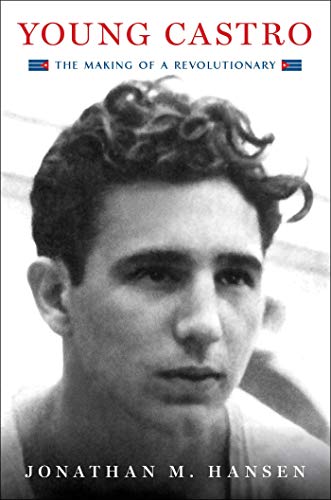Young Castro: The Making of a Revolutionary

When someone says, “She’s a lesbian, but really nice,” the “but” reveals unfair bias. Jonathan Hansen’s “revisionist” account of Fidel Castro is of this sort. It shows Castro to be complex, with frailties and strengths, much like normal folk. What expectation does it answer? A “but” is unacknowledged.
The material is old hat, except for love letters written from prison and details contradicting established belief. Abel Santamaria’s eyes were not gouged out, for instance. He was only brutally murdered. Hansen says, unhelpfully, that people believe what they want to believe.
After Mayan activist Rigoberta Menchú won the Nobel Peace Prize, US and European academics disputed details: Was her brother burned alive or just murdered and thrown in a common grave? Critics of the controversy said the disputes were just a distraction of the bigger picture of suffering in Guatemala, compellingly presented by Menchú.
Hansen doesn’t bother with the bigger picture. He mentions, repeatedly, the goal for “Cuba Libre” and independence. But he doesn’t explain the intellectual, cultural and historical context energizing that goal and making it believable, impossible though it seemed.
Henry Kissinger, no friend of the Cuban Revolution, wrote that Castro in the 1970s was the most revolutionary leader on the world stage. It was because Cuba, at great expense, was in southern Africa fighting apartheid. That anti-racism was Cuba’s motivation is confirmed in CIA documents. The US government knew Cuba was in Africa for the sake of Africans, not for economic or political gain.
A selfless foreign policy is no small feat. But the vision that produced it has no place in Hansen’s book. It’s like a biography of Stephen Hawking that doesn’t mention collapsing stars or imaginary time. Hansen says Castro loved only one thing: the Revolution. He didn’t love Mirta, or Fidelito, or even Celia Sánchez.
Would anyone say of Hawking, “He loved only one thing: Cosmology”? Hawking’s vision(s) of the universe permeated his life. It explained why he sat silently for hours in a roomful of people: doing physics. Without the life of the mind, he could only be odd, maybe mentally ill.
For Castro’s quirks, the explanation is “mood swings.” The century and a half of re-envisioning the human world is missing. We wouldn’t have had Hawking without Hubble, Lemaitre, and Einstein, and Castro could not have been and done what he did without Varela, Bolívar, Luz, and Cespedes. He said it again and again. Yet such thinkers are not in the story.
Hansen mentions Simón Bolívar once, suggesting implausibly that Castro in 1953 didn’t know who he was. Bolívar distinguished political independence from human independence: Political independence was not real independence because Latin Americans, in the eyes of the Empire, were “even lower than servitude, lost or worse absent from the universe.” Independence required claim to humanity.
It required what Victor Hugo called “ruthless dignity”: a claim to humanity that, because of systemic dehumanization, by colonialism and imperialism, must be confrontational. Such “earthy” thinking links Félix Varela to Carlos Manuel de Cespedes, and culminates in José Martí, whose ideas were revived in the early 20th century by Raúl Roa and Juan Marinello, among others.
Castro insistently honored such philosophers, some poets. And herein lies a crucial point. The Revolution that Hansen treats as an obsession was about thinking: how to think. Castro said in Caracus in 1999, “They discovered smart weapons. We discovered that people think and feel.” Earthy thinking.
It is not trivial. Hansen refers to “Cuba Libre.” But he may not know Martí’s claim (1895) that the Cuban Revolutionary Party’s goal was that Cubans know dignity and know that they know dignity. Remarkably, a goal of the revolution, for human independence for Latin Americans, was a fundamental philosophical question: how to know what it means to be human.
Young Castro is missed opportunity. Hansen makes the mistake of many otherwise well-intentioned academics in the North: They assume that only the North produces ideas that energize and transform, motivating sacrifice, driving dynamic creation not just of politics but of the vision that explains it.
Such vision better explains the famous friendship between Castro and Che Guevara than what Hansen offers. He says they both liked books. But interest in books doesn’t explain why one person follows another to “victory or death,” as Guevara committed himself to Castro. More tellingly, Hansen suggests that Guevara left Cuba for Africa because “Cuba was not big enough for the two of them.”
He might have consulted his own government. Piero Gleijeses’ Conflicting Missions draws heavily on CIA documents, explaining with evidence Guevara’s probable intentions. Hansen’s flippant speculation is boring at best, but with the privileged access he had to Cuban documents, it is irresponsible.